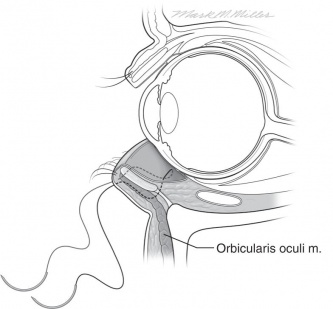Quickert Procedure
All content on Eyewiki is protected by copyright law and the Terms of Service. This content may not be reproduced, copied, or put into any artificial intelligence program, including large language and generative AI models, without permission from the Academy.
The Quickert procedure employs Quickert sutures for the treatment of Entropion. It is most often used in the setting of spastic entropion or early involutional entropion and was first described by Quickert and Rathbun in 1971. Quickert sutures tighten lower lid retractors. Accordingly, the safety, simplicity, quickness, and overall patient satisfaction have been cited as reasons to consider the Quickert procedure for patients in whom these features would be valuable, or patients with higher operative risk [1]
Quickert sutures have been studied in combination with inverted T and lateral tarsal strip procedures to treat involutional entropion. When combined with these procedures that treat horizontal laxity, Quickert sutures purportedly confer the added benefit of reinserting the lower lid retractors. Notably, the addition of Quickert sutures to the inverted T and lateral tarsal strip procedures decreases the recurrence rate of entropion when compared to the Quickert procedure alone. In two case series examining lateral tarsal strip + Quickert sutures, Ho et al, 2005, reported a 12% recurrence at 2 years, and Barnes et al (2004) reported 2% recurrence 9 months.[2] These rates represent an improvement over the 15% and 49% long-term recurrence of Quickert sutures alone reported by Wright et al, 1999, and Jang et al, 2014, respectively. Moreover, in an RCT comparing Quickert /sutures alone to Quickert sutures + lateral tarsal strip, combination surgery resulted in 0% recurrence compared to 21% recurrence with Quickert sutures alone [3] Additionally, in a case series examining the combination of a single Quickert suture with the inverted T procedure, no recurrences of entropion were found after a median follow-up of 49 months [4]. None of these studies endorsed significant complications: Barnes et al, 2006,[5] reported 4% suture granuloma and 2% lower lid ectropion, Ho et al, 2005, reported 2.7% suture granuloma, and Mauriello et al, 1997, reported 3.3% wound dehiscence and 1.7% granuloma.
These results suggest that the Quickert procedure alone is inadequate in providing long-term repair of involutional entropion, but may be an appropriate choice for patients in whom the simplicity, obviation of the need for skin incision, minor complications, and ability to continue anticoagulation treatments of the procedure are valuable. This procedure may also be performed in an inpatient setting as a temporizing measure prior to surgery. Quickert sutures are commonly used to augment the more invasive surgical treatments of entropion, such as the inverted T and lateral tarsal strip procedures.
References
- ↑ Jang SY, SR Choi, JW Jang, SJ Kim, HS Choi. Long-term Surgical Outcomes of Quickert Sutures for Involutional Lower Eyelid Entropion. Journal of Cranio-Maxillo-Facial Surgery. 2014; 42:1629-1631.
- ↑ Ho SF, A Pherwani, SM Elsherbiny, T Reuser. Lateral Tarsal Strip and Quickert Sutures for Lower Eyelid Entropion. Ophthalmic Plastic and Reconstructive Surgery. 2005; 21:345-348.
- ↑ Scheepers MA, R Sing, J Ng, D Zuercher, A Gibson, C Bunce, K Fong, M Michaelides, J Olver. A Randomized Controlled Trial Comparing Everting Sutures with Everting Sutures and a Lateral Tarsal Strip for Involutional Entropion. Ophthalmology. 2010; 117:352-355.
- ↑ Mauriello Jr JA, A Abdelsalam. Modified Corncrib (Inverted T) Procedure with Quickert Suture for Repair of Involutional Entropion. Ophthalmology. 1997; 104: 504-507.
- ↑ Barnes JA, C Bunce, JM Olver. Simple Effective Surgery for Involutional Entropion Suitable for the General Ophthalmologist. Ophthalmology. 2006; 113:92-96.


